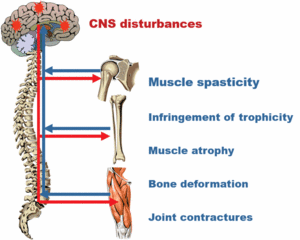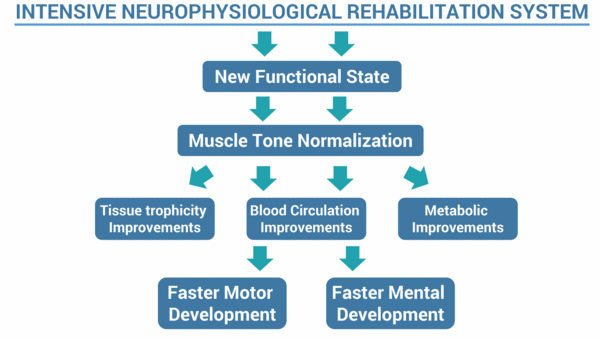Pathophysiological basis
The damage of the central nervous system in Cerebral Palsy is accompanied by the secondary changes of the muscle- skeletal system and other systems of the organism.
High muscle tone, pathological reflexes, improper body position, and pathological movement patterns cause changes of the joints, shortening of the spastic muscles, tendons and ligaments and abnormalities of blood circulation and metabolism. Those pathological changes are accompanied by restriction of joint movement and development of functional blockages.
As is evident in the literature, functional blockages by themselves augment disturbances in trophicity, circulation, and autonomic, functions, resulting in further slowing and distortion of motor development in the child. A pathological vicious circle is formed.
In Cerebral Palsy, functional blockages develop in the majority of the joints. In the study of this phenomenon most authors have addressed joints in the extremities but there is little discussion of the joints of the more than 100 joints of the human spine in which functional blockages are also developing.
Our studies, which began in the mid eighties, showed the important role of the spine in the pathogenesis of Cerebral Palsy. The functional blockages are not limited to a single joint of the spine, but rather the blockages occur in several adjacent vertebrae resulting in polysegmental spinal blockages.
These spinal blockages influence all the organs of the human body which are innervated by the corresponding segments of the spinal cord.
The segmental interactions are disturbed (both with respect to innervation of the organs and systems innervated by the same segment of the spinal cord) as well as those innervated by vertical connections of the segment with the higher centers of the nervous system (connections with brain stem, basal ganglia and cortex).
Proprioception may also be affected in CP. In the joints, tendons and muscles there are receptors that relay information about body position, equilibrium and movements. They are muscle spindles in the muscles, Golgi tendon organs in the tendons and joint kinesthetic receptors in the joints.
Information from those receptors is essential not only for the performance of all movements but also for motor training and learning new movements.
Recent studies have shown that functional spinal blockages are blocking and distorting the flow of proprioceptive information from the muscular-skeletal system through the central nervous system which further complicates the motor development of the CP patient.
In an attempt to correct the above-mentioned pathological signs, the method of biomechanical correction of the spine and large joints has been developed. This method became the basis of Intensive Neurophysiological Rehabilitation System.
The technique of the biomechanical correction releases functional blockages of the spine, restores joints mobility and opens the “gate” for the flow of the proprioceptive information to the central nervous system and creates a new functional state in the organism.
The results of this technique are not limited to the changes in joint mobility, but are accompanied by complex changes in the organism – the so-called new functional state is created. The muscle tone is normalized, and tissue trophicity, blood circulation, and metabolism are improved. The new functional state significantly enhances the possibility for the faster motor and mental development. However, isolated use of the biomechanical correction of the spine is not sufficient. It only creates the basis for the possible future development of the child.
This rehabilitation approach assumes that the human body is a complex self-organizing system, made up of many subsystems which can exist and develop normally only if their interconnections are ordered and harmonious.
The damage or malfunction of one subsystem disturbs the function of the entire organism as is the case in CP: when self- regulation is not sufficient, the dysfunction of the whole organism occurs.
Influencing the different chains of the pathological process with different modalities, our task is to break the pathological vicious circle, create a new functional state in the organism and open up the possibilities for faster motor development.
Hence the Intensive Neurophysiological Rehabilitation System was created. It combines different treatment modalities that complement and reinforce each other. The method of biomechanical correction of the spine, combined with many other treatment means is used to prepare the child for the correction, sustain the achieved results, create correct movement patterns and accelerate motor and mental development.
The pathophysiological mechanism presented above is only one of several hypotheses regarding the effects of this treatment method. Other hypotheses of the therapeutic influence of the Kozyavkin Method are now in the process of development.


